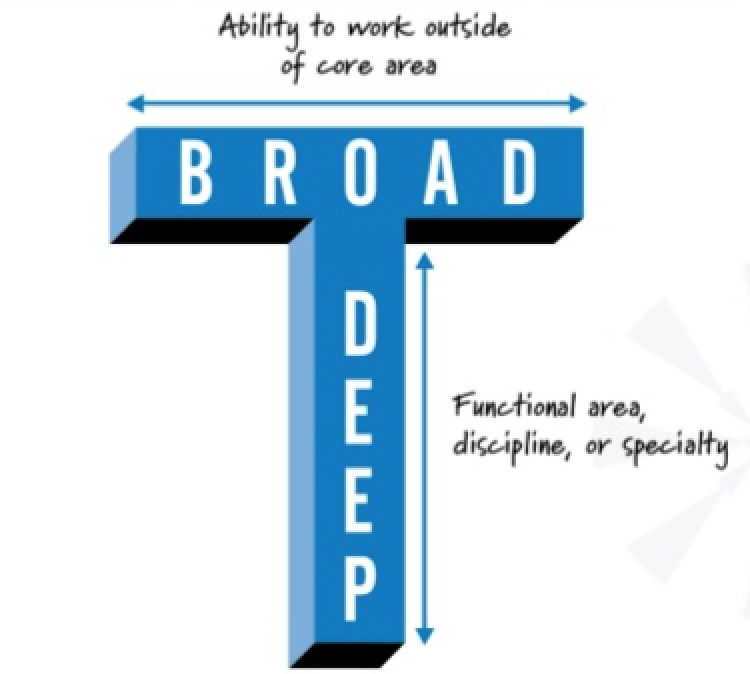In industry, a person’s skill set can be described using one of two metaphors: the letter “I” and the letter “T.”
A person with “I-shaped” skills has very deep skills in a single domain. This vertical line in the letter “I” represents this depth in a single area.
In contrast, the person with “T-shaped” skills has deep skills in a single domain as well, but also possesses breadth across multiple disciplines.
The vertical line in the letter “T” represents the depth in a single area. The horizontal line at the top of the letter “T” represents the breadth across multiple domains.
The term “T-shaped skills” seems to have been popularized by IDEO, the world-renowned product design company. I’ve also seen some sporadic references to McKinsey people using the term to describe the kind of people that make good consultants.
I really like the metaphors, as they provide a better way of expressing an idea that I’ve been advocating now for years.
Firms hire people with I-shaped skills for entry-level, individual contributor-type roles.
You need a certain task done. You hire someone who is very good at getting that task done.
You don’t need them to strategize. You don’t need them to innovate, invent, or collaborate. You just need them to do the one thing they were hired for over and over again.
However, as you move up the career ladder, T-shaped skills become more vital.
Managers and leaders manage their teams to integrate with the work of other groups in the organization.
In order to work well with other groups, you need to know your area extremely well. But, you also need to know enough about the other group’s areas to understand how your work impacts their work.
T-shaped people are the glue between departments, functional areas, and teams.
This is why a strong I-shaped individual contributor will end up working for a T-shaped manager, even though the manager’s technical knowledge isn’t as deep as the individual contributor.
This is how you can work for a boss that’s technically less strong than you.
It’s not a defect in the people management process of your company.
It is by design.
Armed with this insight, what do you do about it?
Develop more T-shaped skills.
It means learning more about other functional areas — to develop your cross-functional breadth.
It means developing your people skills and EQ skills so that you can interact with, work with, and collaborate with people different than yourself.
It means pursuing stretch assignments that are slightly beyond your proven skill set.
This is why the Fortune 500 companies with the strongest track record in developing future executives constantly rotate their highest potential employees across very different jobs.
Recent studies suggest that If you’re in the top 1% at General Electric, you will probably move from being an engineer to becoming a financial analyst… from being a financial analyst to working in sales… and so on.
This depth + diversity approach is a proven way to become a higher caliber professional and executive.
If you don’t have a deliberate plan to work on your T-shaped skills, I’d suggest making T-shaped skills a consideration in your career planning.
Written By Victor Cheng on the 17th of August, 2017.
